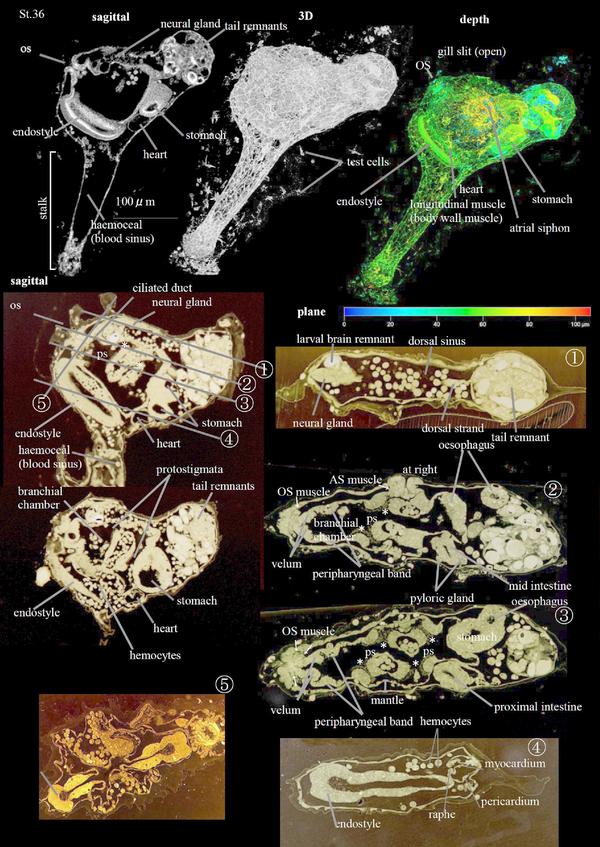
Stage 36
At the Late Body Axis Rotation Stage (CirobuD:0000059) 45-60 h (2 dpf)), the angle between the endostyle axis and the axis passing through the stalk is 30°- 60° (Stage 36). With respect to the previous stage, some new entities are now recognizable. At the gut level, the pyloric gland (CirobuA:0000705) emerged from the pyloric caecum. At the neural system level, the neural complex (CirobuA:0000659), composed of the cerebral ganglion (CirobuA:0000582), and the neural gland complex (CirobuA:0000661) are distinguishable. The latter is formed of the neural gland body, which anteriorly exhibits a gland aperture, the ciliated funnel (CirobuA:0000584). The latter is located in the dorsal tubercle (CirobuA:0000932), on the roof of the prebranchial zone. Posteriorly, the neural gland body elongates into the dorsal strand (CirobuA:0000930). In the adult, a dorsal strand plexus (CirobuA:0000931) extends along the dorsal strand. Some nerves (CirobuA:0000929) are elongating from the neurons located in the cerebral ganglion.
The filter-feeding activity starts at this stage. Consequently, multiple entities linked to the respiratory and alimentary tract become physiologically functioning. Food, brought by water entering the oral siphon, reaches the branchial cavity (delimited by the branchial epithelium (CirobuA:0000677)) and passes through the oesophagus , the stomach and the intestine (divided into the proximal (CirobuA:0000872), mid (CirobuA:0000655), and distal intestine (CirobuA:0000631)) for digestion. Fecal pellets are eliminated through the anus (CirobuA:0000362), which opens into the atrial chamber. In the branchial chamber, the endostyle is now characterized by its zones in the form of eight symmetrical longitudinal cellular bands (from the median zone 1 (CirobuA:0000782) to peripheral zone 8 (CirobuA:0000790))(Burighel et al., 1997; Hirano and Nishida, 2000). It is involved in mucus production for filtration. The oral mechanoreceptor, the coronal organ (CirobuA:0000923), is developing on the oral tentacles and the velum. It controls the circulating seawater inside the animal body, together with the atrial cupular organ (CirobuA:0000924). The circular muscular system (CirobuA:0000859) and longitudinal muscular system (CirobuA:0000860), responsible for body contraction, become recognizable in the body wall. The heart , with its inner contractile myocardium (CirobuA:0000886) and outer pericardium (CirobuA:0000679) joined by a rafe (CirobuA:0000887), is now beating.